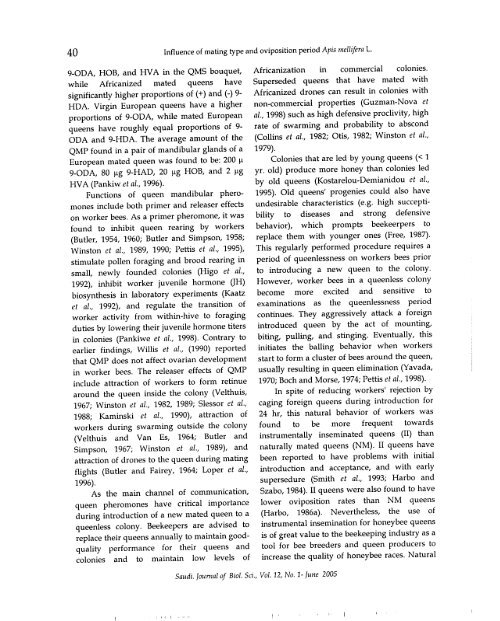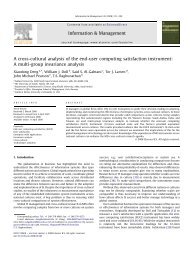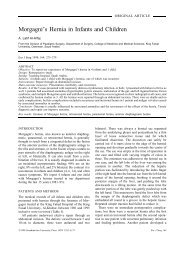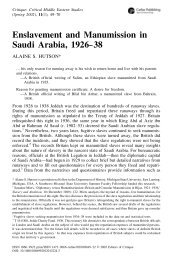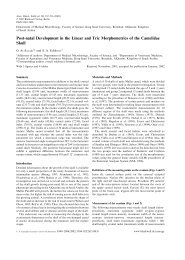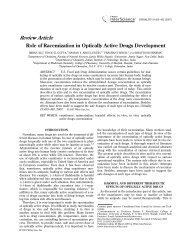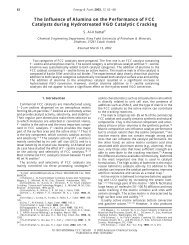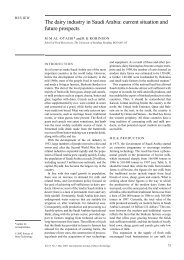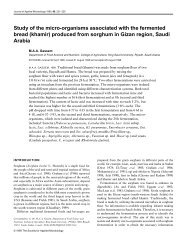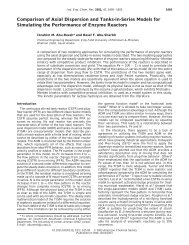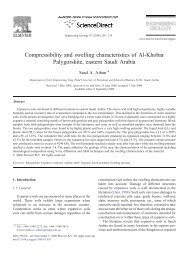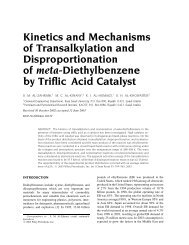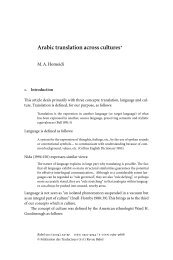Influence of Mating Type and Oviposition Period on Mandibular ...
Influence of Mating Type and Oviposition Period on Mandibular ...
Influence of Mating Type and Oviposition Period on Mandibular ...
You also want an ePaper? Increase the reach of your titles
YUMPU automatically turns print PDFs into web optimized ePapers that Google loves.
9-0DA, HOB, <str<strong>on</strong>g>and</str<strong>on</strong>g> HVA in the QMS bouquet,<br />
while Africanized mated queens have<br />
significantly higher proporti<strong>on</strong>s <str<strong>on</strong>g>of</str<strong>on</strong>g> (+) <str<strong>on</strong>g>and</str<strong>on</strong>g> (-) 9-<br />
HDA. Virgin European queens have a higher<br />
proporti<strong>on</strong>s <str<strong>on</strong>g>of</str<strong>on</strong>g> 9-0DA, while mated European<br />
queens have roughly equal proporti<strong>on</strong>s <str<strong>on</strong>g>of</str<strong>on</strong>g> 9-<br />
ODA <str<strong>on</strong>g>and</str<strong>on</strong>g> 9-HDA. The average amount <str<strong>on</strong>g>of</str<strong>on</strong>g> the<br />
QMP found in a pair <str<strong>on</strong>g>of</str<strong>on</strong>g> m<str<strong>on</strong>g>and</str<strong>on</strong>g>ibular gl<str<strong>on</strong>g>and</str<strong>on</strong>g>s <str<strong>on</strong>g>of</str<strong>on</strong>g> a<br />
European mated queen was found to be: 200 I.l<br />
9-0DA, 80 I.lg9-HAD, 20 I.lgHOB, <str<strong>on</strong>g>and</str<strong>on</strong>g> 2 I.lg<br />
HVA (Pankiw et al., 1996).<br />
Functi<strong>on</strong>s <str<strong>on</strong>g>of</str<strong>on</strong>g> queen m<str<strong>on</strong>g>and</str<strong>on</strong>g>ibular pherom<strong>on</strong>es<br />
include both primer <str<strong>on</strong>g>and</str<strong>on</strong>g> releaser effects<br />
<strong>on</strong> worker bees. As a primer pherom<strong>on</strong>e, it was<br />
found to inhibit queen rearing by workers<br />
(Butler, 1954, 1960; Butler <str<strong>on</strong>g>and</str<strong>on</strong>g> Simps<strong>on</strong>, 1958;<br />
Winst<strong>on</strong> et al., 1989, 1990; Pettis et al., 1995),<br />
stimulate pollen foraging <str<strong>on</strong>g>and</str<strong>on</strong>g> brood rearing in<br />
small, newly founded col<strong>on</strong>ies (Higo et al.,<br />
1992), inhibit worker juvenile horm<strong>on</strong>e OH)<br />
biosynthesis in laboratory experiments (Kaatz<br />
et al., 1992), <str<strong>on</strong>g>and</str<strong>on</strong>g> regulate the transiti<strong>on</strong> <str<strong>on</strong>g>of</str<strong>on</strong>g><br />
worker activity from within-hive to foraging<br />
duties by lowering their juvenile horm<strong>on</strong>e titers<br />
in col<strong>on</strong>ies (Pankiwe et al., 1998). C<strong>on</strong>trary to<br />
earlier findings, Willis et al., (1990) reported<br />
that QMP does not affect ovarian development<br />
in worker bees. The releaser effects <str<strong>on</strong>g>of</str<strong>on</strong>g> QMP<br />
include attracti<strong>on</strong> <str<strong>on</strong>g>of</str<strong>on</strong>g> workers to form retinue<br />
around the queen inside the col<strong>on</strong>y (Velthuis,<br />
1967; Winst<strong>on</strong> et al., 1982, 1989; Slessor et al.,<br />
1988; Kaminski et al., 1990), attracti<strong>on</strong> <str<strong>on</strong>g>of</str<strong>on</strong>g><br />
workers during swarming outside the col<strong>on</strong>y<br />
(Velthuis <str<strong>on</strong>g>and</str<strong>on</strong>g> Van Es, 1964; Butler <str<strong>on</strong>g>and</str<strong>on</strong>g><br />
Simps<strong>on</strong>, 1967; Winst<strong>on</strong> et al., 1989), <str<strong>on</strong>g>and</str<strong>on</strong>g><br />
attracti<strong>on</strong> <str<strong>on</strong>g>of</str<strong>on</strong>g> dr<strong>on</strong>es to the queen during mating<br />
flights (Butler <str<strong>on</strong>g>and</str<strong>on</strong>g> Fairey, 1964; Loper et al.,<br />
1996).<br />
As the main channel <str<strong>on</strong>g>of</str<strong>on</strong>g> communicati<strong>on</strong>,<br />
queen pherom<strong>on</strong>es have critical importance<br />
during introducti<strong>on</strong> <str<strong>on</strong>g>of</str<strong>on</strong>g> a new mated queen to a<br />
queenless col<strong>on</strong>y. Beekeepers are advised to<br />
replace their queens annually to maintain goodquality<br />
performance for their queens <str<strong>on</strong>g>and</str<strong>on</strong>g><br />
col<strong>on</strong>ies <str<strong>on</strong>g>and</str<strong>on</strong>g> to maintain low levels <str<strong>on</strong>g>of</str<strong>on</strong>g><br />
Africanizati<strong>on</strong> in commercial col<strong>on</strong>ies.<br />
Superseded queens that have mated with<br />
Africanized dr<strong>on</strong>es can result in col<strong>on</strong>ies with<br />
n<strong>on</strong>-commercial properties (Guzman-Nova et<br />
al., 1998) such as high defensive proclivity, high<br />
rate <str<strong>on</strong>g>of</str<strong>on</strong>g> swarming <str<strong>on</strong>g>and</str<strong>on</strong>g> probability to absc<strong>on</strong>d<br />
(Collins et al., 1982; Otis, 1982; Winst<strong>on</strong> et al.,<br />
1979).<br />
Col<strong>on</strong>ies that are led by young queens « 1<br />
yr. old) produce more h<strong>on</strong>ey than col<strong>on</strong>ies led<br />
by old queens (Kostarelou-Demianidou et al.,<br />
1995). Old queens' progenies could also have<br />
undesirable characteristics (e.g. high succeptibility<br />
to diseases <str<strong>on</strong>g>and</str<strong>on</strong>g> str<strong>on</strong>g defensive<br />
behavior), which prompts beekeerpers to<br />
replace them with younger <strong>on</strong>es (Free, 1987).<br />
This regularly performed procedure requires a<br />
period <str<strong>on</strong>g>of</str<strong>on</strong>g> queenlessness <strong>on</strong> workers bees prior<br />
to introducing a new queen to the col<strong>on</strong>y.<br />
However, worker bees in a queenless col<strong>on</strong>y<br />
become more excited <str<strong>on</strong>g>and</str<strong>on</strong>g> sensitive to<br />
examinati<strong>on</strong>s as the queenlessness period<br />
c<strong>on</strong>tinues. They aggressively attack a foreign<br />
introduced queen by the act <str<strong>on</strong>g>of</str<strong>on</strong>g> mounting,<br />
biting, pulling, <str<strong>on</strong>g>and</str<strong>on</strong>g> stinging. Eventually, this<br />
initiates the balling behavior when workers<br />
start to form a cluster <str<strong>on</strong>g>of</str<strong>on</strong>g> bees around the queen,<br />
usually resulting in queen eliminati<strong>on</strong> (Yavada,<br />
1970;Boch <str<strong>on</strong>g>and</str<strong>on</strong>g> Morse, 1974;Pettis et al., 1998).<br />
In spite <str<strong>on</strong>g>of</str<strong>on</strong>g> reducing workers' rejecti<strong>on</strong> by<br />
caging foreign queens during introducti<strong>on</strong> for<br />
24 hr, this natural behavior <str<strong>on</strong>g>of</str<strong>on</strong>g> workers was<br />
found to be more frequent towards<br />
instrumentally inseminated queens (II) than<br />
naturally mated queens (NM). II queens have<br />
been reported to have problems with initial<br />
introducti<strong>on</strong> <str<strong>on</strong>g>and</str<strong>on</strong>g> acceptance, <str<strong>on</strong>g>and</str<strong>on</strong>g> with early<br />
supersedure (Smith et al., 1993; Harbo <str<strong>on</strong>g>and</str<strong>on</strong>g><br />
Szabo, 1984). II queens were also found to have<br />
lower ovipositi<strong>on</strong> rates than NM queens<br />
(Harbo, 1986a). Nevertheless, the use <str<strong>on</strong>g>of</str<strong>on</strong>g><br />
instrumental inseminati<strong>on</strong> for h<strong>on</strong>eybee queens<br />
is <str<strong>on</strong>g>of</str<strong>on</strong>g> great value to the beekeeping industry as a<br />
tool for bee breeders <str<strong>on</strong>g>and</str<strong>on</strong>g> queen producers to<br />
increase the quality <str<strong>on</strong>g>of</str<strong>on</strong>g> h<strong>on</strong>eybee races. Natural


